Born on drugs: The goal is to keep kids with parents. Sometimes, that’s dead wrong
This series was produced with the support of the USC Annenberg Center for Health Journalism Impact Fund.
Other stories in this series include:
Born on drugs: Babies from addicted moms are increasing at an alarming rate in California
Born on drugs: Predictions about crack babies didn’t come true, offering hope for opioid era
Lawmakers vow to push stiffer regulations on addiction treatment in California
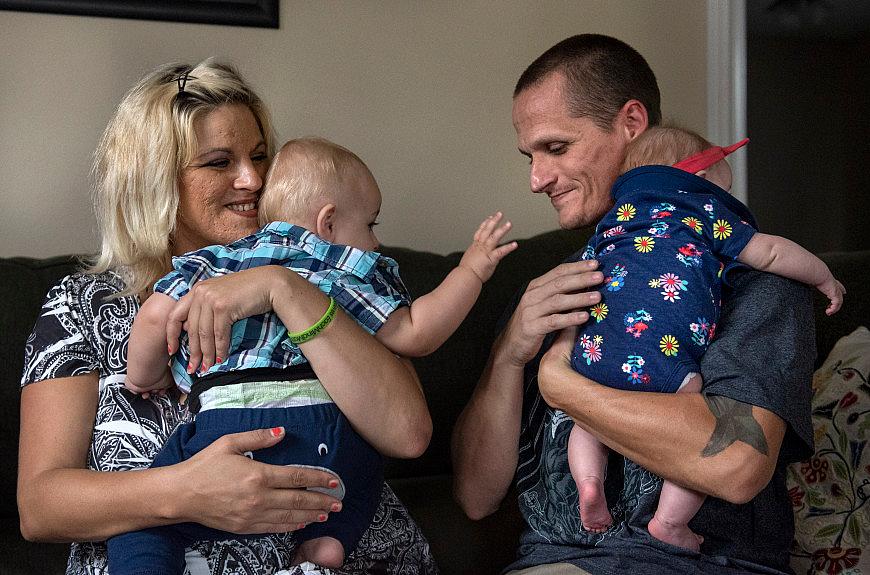
Cheyenne Easter and Jeremy Jones with Sebastian, 13 months and Charlotte, 3 months, spent years living on the streets addicted to drugs and alcohol. They journeyed into the legal system and eventually into sobriety. They are hoping to be awarded full custody of their children early next year.
(Photo Credit: Mindy Schauer, Orange County Register/SCNG)
Cheyenne Easter turned up on the riverbed under the 22 freeway in the winter of 2016, shortly after her latest DUI.
Jeremy Jones was already living there, in a tent, with a pit bull named Haley. He thought Easter was beautiful.
Jones’ drug of choice was vodka. Easter’s was meth, which she used to stay awake in the wee hours; a homeless woman’s strategy to fend off rapists.
There were lots of people camping under the 22 that first night, all abuzz over the new girl. Jones — not a big guy, sometimes bullied — would need his wits to pry her away from the crowd and get to know her better. So rather than booze or drugs, Jones offered a Dr. Pepper and some gummy worms, and asked if she’d join him for a walk with Haley.
Jeremy Jones sorts through his certificates of sobriety that he keeps in a folder at his Anaheim apartment on Saturday, October 20, 2018. He hopes to get a job in food service. (Photo Credit: Mindy Schauer, Orange County Register/SCNG)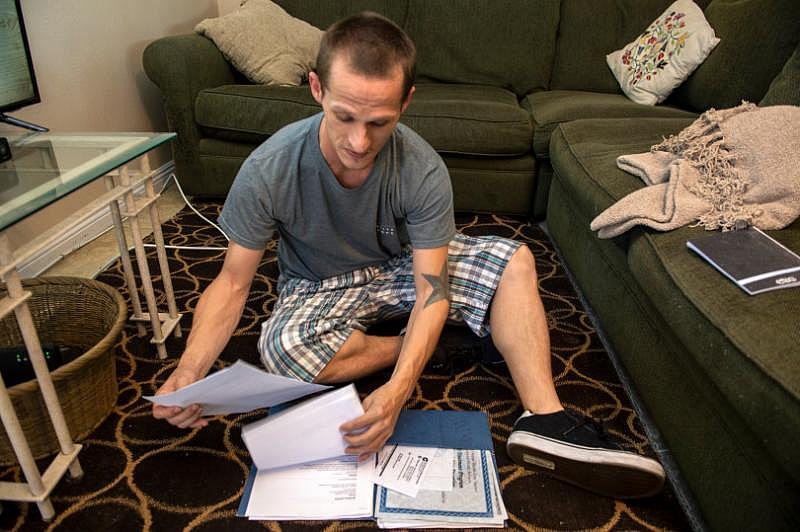
Easter loved dogs, and gummy worms, so she jumped up to join him. They strolled the riverbed, wandered onto the grounds of the nearby golf course and shared the sorrows that had brought them to this particular moment.
Then the automatic sprinklers sprang to life, catching them in the crossfire. But rather than running for cover, Easter grabbed the dog’s paws and danced, twirling in an improvised waltz as she implored God – and Mickey Mouse – to deliver her a happily-ever-after.
Jones watched with trepidation.
“I was like, ‘Oh, you’re crazy,’ ” he said. “‘You’re crazy.’ ”
By the summer of 2018, Easter and Jones would have two children.
Each time she learned she was pregnant, Easter said, she stopped using drugs. But between pregnancies, she and Jones used again. Both babies would be swept into California’s vast child protective system.
Easter and Jones were left to wrestle with their demons – and California’s child welfare system – hellbent on getting their children back.
The system’s job is to wrap kids in its protective arms, get their parents the help they need to be successful moms and dads, and keep families together.
Indeed, the number of kids in California’s child protection system care plunged almost 50 percent between 2000 and 2018. The number of children waiting for adoption after their parents’ rights was severed was down about 40 percent. But the number of infants (12 months or younger) in the system shot up more than 9 percent.
The help provided to parents struggling with addiction varies from county to county, judge to judge and even case to case. Likewise, parents vary in their willingness to accept the help offered and do the challenging work that sobriety requires.
On their dizzying journey, Easter and Jones repeatedly leaned on a nonprofit that helps the homeless, the Illumination Foundation, for support.
But they also learned that if they really wanted that happily-ever-after, they had to create it themselves.
‘But, you’re using heroin’
Dr. Bryan Oshiro leaned close to the monitor, examining the ghostly, three-dimensional face of an unborn fetus. It was about five months old.
“There are so many things that can go wrong,” he said, his voice echoing through the darkened examining room.

Oshiro is an obstetrician-gynecologist at Riverside University Health System-Medical Center who specializes in treating pregnant women who have drug problems. Most of his patients use multiple drugs, from meth to alcohol to heroin, he said.
Once they realize they’re pregnant – a discovery often delayed because drug use can disrupt the menstrual cycle – their universe can crystallize with a violent clarity. Unable or unwilling to get clean for themselves, many find a steely resolve to get clean for their babies.
Oshiro examined the ultrasound. Drug use during pregnancy can lead to miscarriage, seizures, premature membrane ruptures and separation of the placental lining from the uterus, as well as difficult deliveries, premature births, underweight babies, and a host of other ills.
So he scanned the phantasmal images of the upper jaw, lower jaw, spine, hips, heart, liver, kidneys, nodding at what he saw. With this fetus, everything appeared to be forming correctly.
To bolster the opioid-using women’s newfound resolve to get clean, Oshiro tells them about medication-assisted treatment. Buprenorphine – the gold standard for treating opioid addiction – blocks cravings and allows them to get on with their lives, much like methadone but without the daily visit to a clinic. Only three doctors in Moreno Valley currently have permission from the federal government to prescribe buprenorphine, and Oshiro is one of them.
He ticks off the benefits of medication-assisted treatment: Their babies are half as likely to experience withdrawal symptoms. After delivery, moms get the benefit of the doubt from the child protection system, so their babies aren’t taken away. They’re encouraged to breastfeed. They get help learning, and practicing, how to be a parent.
And, if needed, doctors and nurses and therapists will let dependency court know how hard the moms are working to stay sober.
Still, women often snub buprenorphine, insisting they don’t want to expose their baby to drugs.
“But, you’re using heroin,” Oshiro counters.
They often don’t – or won’t – comprehend the difficulty of the task before them.
‘Goodbye. Forever.’
In a nondescript conference room in an industrial park near the 22 freeway, five women – four of them pregnant and one whose three children were in protective custody – sat around a long table.
One of those women, Jen R., began reading aloud the goodbye letter she’d written to her drug of choice.
“Dear Methamphetamine…”
Jen was five months pregnant, living at the Casa Teresa emergency maternity shelter in Orange and getting counseling and educational services here, at the nearby Mariposa Center.
The counselor at Mariposa, Sylvia Jacques, tilted her head sympathetically to one side, silently encouraging her to continue.
“I thought we were going to be together forever,” Jen read. “But you’re no good for me. So goodbye. Forever.”
Jacques beamed. She knew Jen was tired; that she wanted to take a break and grab a smoke. Still, Jacques pressed.
Jen’s time at Casa was hitting turbulence. She was argumentative, endangering her spot in a refuge that grants women months of safe shelter and assistance, plus months of help after their babies are born.
“Why do you think you have this impulse to sabotage yourself?” Jacques asked.
Jen’s face crumpled.
Counselor Sylvia Jacques runs a support group for pregnant women and mothers who are dealing with addiction. “Life is not easy,” she tells the dozen women in a recent evening meeting. “But it’s doable as long as you have the right tools,” she adds. (Photo by Mindy Schauer, Orange County Register/SCNG)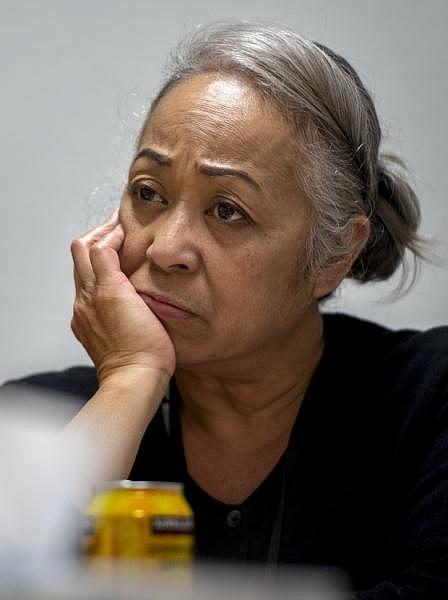
“I sabotage things because I don’t feel like I deserve good things,” she said. “I don’t think I deserve all this goodness. I don’t think I deserve to have this baby.”
Once, she sold drugs. People got hurt; some wound up dead. That past haunted her.
“That’s the old you,” Jacques said softly. “Give yourself a chance.”
Don’t call the authorities, yet
The women say they quit using drugs the second they realized they were pregnant – but often that’s five or six months in. It’s a fairly common scenario, officials said, and it can lead to its own complications.
Babies exposed to drugs in the early, critical months of their development might develop learning difficulties and behavioral problems. If their moms stop using, neither baby nor mom will test “pos-tox’ at birth – thus escaping the watchful eyes of authorities but missing out on the early help that can make a vital difference in all their lives.
“Once they hit preschool and kindergarten, these little ones that are slipping through the cracks, their destiny can just be so sad,” said Tammy Johnson, a neonatal intensive care nurse at Riverside University Health System Medical Center.
Years later, children are often misdiagnosed with mental health disorders when they’re actually suffering from prenatal exposure to alcohol, cocaine or other drugs, according to the work of Ira J. Chasnoff, a professor of clinical pediatrics at the University of Illinois College of Medicine.

These issues are treatable and preventable with early intervention, Chasnoff found. But without universal screening, the need for such help might not surface until it’s too late.
“Thousands of children in California may be at a disadvantage for lack of that intervention,” said nurse Johnson.
While laws in 23 states categorize drug use during pregnancy as a form of child abuse – and three states consider it grounds for civil commitment – California is not one of them. Here, pregnant addicts are directed to medical help and treatment programs, but their participation is voluntary. Officials won’t alert child protective services about the mother’s problem unless other children, already in the woman’s care, also are at risk.
“The way that (Child Protective Services) looks at things is, there’s no child that needs to be protected, because the child has not been born yet,” said Shawn Briggs, a licensed clinical social worker at Riverside University Health System Medical Center.
When the baby arrives, and child protection officials are called, Briggs might suggest that a mom isn’t quite ready to take her newborn home and that a temporary placement might give her breathing room to get a solid footing in her recovery. Becoming a new mom is stressful for the best-prepared women; struggling with addiction on top of that can lead to danger for them both.
The state, however, is under no obligation to follow that advice.
Recently, a mom who had lost three children to the child welfare system in Riverside County gave birth to a fourth, drug-exposed baby. Briggs had two competing concerns: What if this is the baby that changes her? And what happens if she doesn’t change at all? County child protection officials allowed the woman to take the baby home. In some ways, everyone now holds their breath.
“California is a reunification state,” said Briggs. “That was embedded in me through my education process. They’re always going to work towards reuniting families, because there’s this belief that that’s better for the child overall.
“I don’t always agree with that,” she added.
“I don’t see how we can help moms be successful by allowing them to go home with infants when they have come in predisposed to drugs,” Briggs said. “Mom hasn’t had enough clean time to be successful.”
Jess Ann Hite, an attorney from the city of Orange who has been representing children in dependency court for 30 years, agrees.
“They come in with the best of intentions,” Hite said of the parents. “ ‘I’m going to change.’ And the realities are, because of the addiction, the drugs scream louder than the babies.”
For child social workers, the two goals – protect the child; keep the family together – can be in tragic conflict.
Deadly benefit of the doubt?
It’s unclear how often the push to keep families together ends badly. Child welfare proceedings are secret and the involvement of Social Services is not always disclosed when parents face criminal charges.
But some three-quarters of child deaths due to abuse and neglect tracked by the state of California – and some 60 percent of serious injuries – happened in families that had previous contact with the child welfare system.
Examples of the system backfiring can be horrific.
Maggie Jean Wortman’s doctors knew she was a drug user. Court records show she tested positive for methamphetamine when she was six months pregnant.
On Oct. 15, 2010, Wortman, of Loleta, gave birth to a son. Barely six weeks later, the baby was dead.
Wortman told police that she continued to smoke meth “a couple of times a week” for several weeks after the baby was born, even though she was nursing. In 2012, she pleaded guilty to voluntary manslaughter by passing a lethal dose of the drug to her baby through her breast milk. She was sentenced to six years in prison.
Baby Leo Holtz’s parents had a history of drug use as well, court records show.
An autopsy found fatal levels of fentanyl in 10-month-old Leo Holtz’s stomach and bloodstream. (Cuyahoga County Medical Examiner’s Office via AP)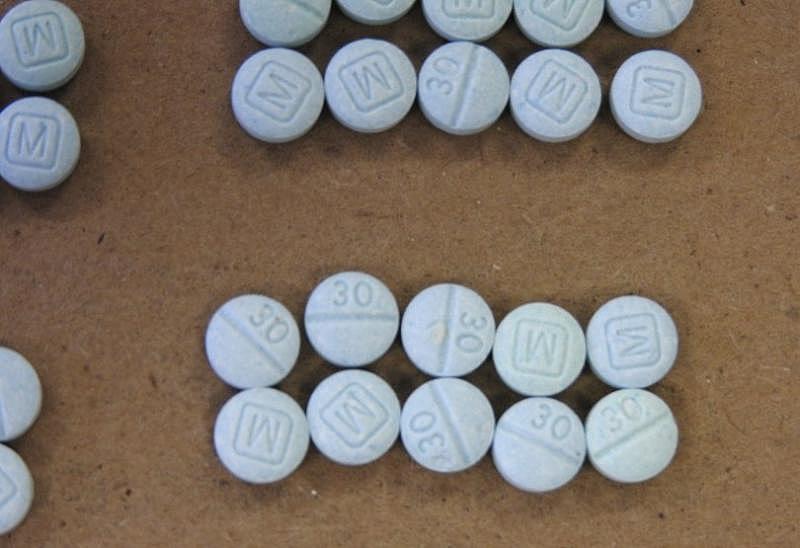
Chantil Kalagian and Colin Holz were on probation when authorities allowed them to take Leo home. On the morning of Sept. 18, 2017, the 10-month-old was snuggling in bed with his parents. His father had stashed some blue pills stashed in his shorts pocket — pills that were supposed to be oxycodone hydrochloride, an opioid with a high propensity for abuse — and some pills spilled out.
Baby Leo stuck some in his mouth.
He was blue and unresponsive when Kalagian and Holz woke up, and he was declared dead at Rady Children’s Hospital, according to an arrest warrant.
An autopsy found fatal levels of fentanyl – a drug that’s 50 to 100 times more potent than morphine, and 30 to 50 times more potent than heroin – in the baby’s system. Prosecutors charged Holz and Kalagian with felony child abuse. They have pleaded not guilty.
The wisdom of California’s goal – keep families together even when parents struggle with addiction – is called into stark relief by such tragedies.
“There’s tension between believing in recovery and seeing it in people’s lives – millions of people who’ve gotten clean and sober – and knowing the damage that’s being done to children every day they go home to a house in which one or more caretakers is drug or alcohol dependent,” said Sidney L. Gardner, president of Children and Family Futures.
“That’s nine million kids nationwide. Lo and behold, those are the kids who end up affected by special education, delinquency, on the street, in trouble. Knowing that some parents get better, and some kids are deeply damaged….” Gardner’s voice trailed off.
“We need to draw that line.”
Into the system
Homeless, using meth, living under the 22 freeway near the Santa Ana River; Cheyenne Easter was five or so months along when she realized she was pregnant.
Gobsmacked, she walked a couple of miles to Disneyland. “I was like, ‘God, am I supposed to have a baby? What am I supposed to do?’”
Beseeching God – and Mickey Mouse – for her happily-ever-after had become a ritual for Easter, so when the cheerful steel drums from “Under the Sea” blasted from the overhead speakers at Disneyland, she took notice. “Just look at the world around you/Right here on the ocean floor/Such wonderful things surround you/What more is you lookin’ for?” Then came fantastical bits from “Alice in Wonderland.”
“It was like, ‘Hey, you’re done with Wonderland. Now you’re going back to reality,’ ” Easter said.
She broke her meth pipe, buried it in the dirt and headed back to the tent she called home.
“I want to be a mom,” she said. “I felt in my heart that God was going to grant me a family.”
Cheyenne Easter gets emotional while recounting her days as a homeless addict on Wednesday, October 3, 2018. (Photo Credit: Mindy Schauer, Orange County Register/SCNG)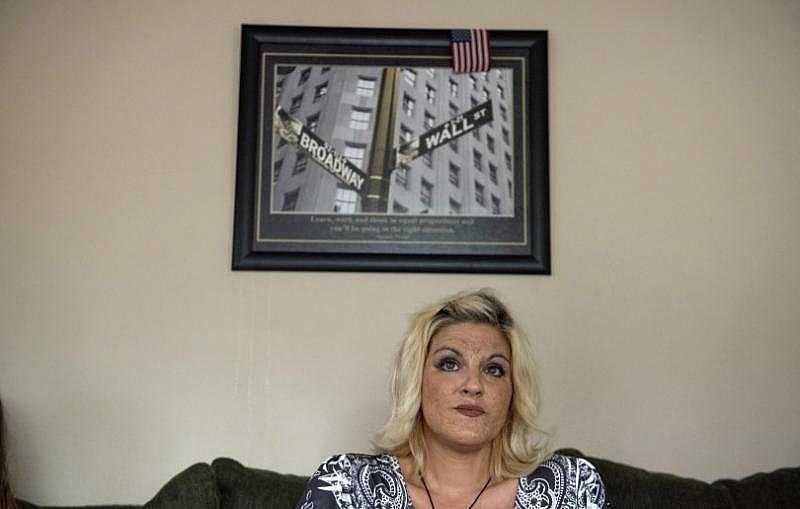
That was April, 2017. Workers for the nonprofit Illumination Foundation made sure she got to her prenatal appointments and convinced Easter – and boyfriend Jeremy Jones – that they didn’t need to be homeless anymore. Illumination helped them get into an apartment in Huntington Beach. Their son, Sebastian – named after the conductor from “The Little Mermaid” – was born in August.
It was a rough transition. After living under a freeway for so long, they’d talk “really, really, really loud – like our hearing just went away,” Easter said. “We started getting into arguments and the cops kept coming over – like, even if I asked him if he wants hot sauce on his eggs, we’d have like 20 cops in our house.”
They started using again. In October 2017, Easter kicked Jones out of the house – but not before following him outside and hurling a few punches.
Someone called police. She was arrested for domestic violence. Jones was too intoxicated to take care of three-month-old Sebastian, so the baby was taken into protective custody.
Staff writer Tony Saavedra contributed to this report.
[This story was originally published by The Orange County Register.]

